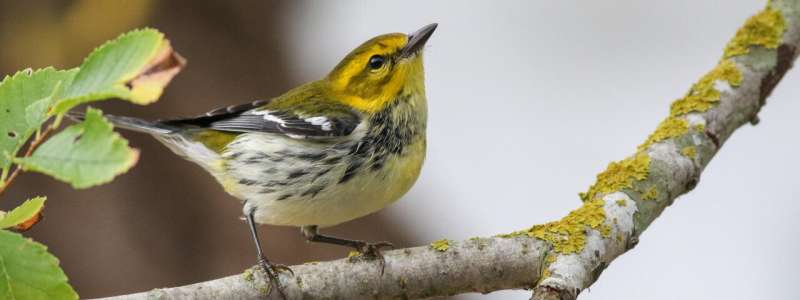This article has been reviewed according to Science X's editorial process and policies. Editors have highlighted the following attributes while ensuring the content's credibility:
fact-checked
peer-reviewed publication
proofread
New map of 'stopover hotspots' provides insights for conservation of eastern US migratory landbirds

Every autumn, billions of birds migrate across the eastern U.S. en route to their wintering sites. As the birds undertake their journeys, however, they are faced with increasing threats, including habitat loss, storms, feral cats and other predators, pesticides, collisions with buildings, and climate change. Not only are individual species impacted by these threats, but so is the migratory phenomenon itself.
A new study published in the journal Proceedings of the National Academy of Sciences presents the first comprehensive map of autumn stopover hotspots of landbirds for the eastern United States. Stopover sites are locations where birds pause between migratory flights in order to rest and refuel before resuming their journeys. The new map created by the researchers can inform where conservation efforts would be most effective.
"This is the first time we've had a comprehensive picture of where songbirds are stopping over for the entirety of the eastern United States," said David Wilcove, professor of Public Affairs and Ecology and Evolutionary Biology and the High Meadows Environmental Institute and a co-author on the study. "It gives us a powerful new tool for identifying the key habitats these birds are using during their epic migrations," Wilcove said.
The researchers used data collected from a national network of weather radar stations to identify "stopover hotspots," or sites that consistently support a high number of migratory birds year to year. Weather radar images capture not only precipitation but also migrating birds, but separating the birds from the precipitation (and other things) requires a great deal of image processing.
The study finds that landbirds migrate across a broad front through the eastern United States, with relatively more birds following the Mississippi River and, to a lesser extent, the Appalachian Mountains. By examining the migration at finer spatial scales, the researchers were able to identify hotspots that support high densities of birds from year to year on their migratory journeys.
The study also reports that at these finer scales, there are high concentrations of birds in the pockets of broadleaf forests remaining in areas that have been largely deforested to grow crops, such as the Midwest. Previously, these forest fragments were seen as having relatively little value for songbirds because they do not generally support large populations of them during the breeding season. But during the fall migration, they become important rest and refueling spots.
"Small pockets of deciduous forest are often neglected in conservation planning because birds have low breeding success in these spaces," said Fengyi Guo, lead author of the study and a Ph.D. candidate in the department of Ecology and Evolutionary Biology at Princeton University. "But the entire population moves across the continent twice annually. Many of them depend on food and shelter in these forest pockets to complete their migration" Guo said.
Another novel finding is that there are high concentrations of birds in the forests along the edge of the Midwest prairie region, now largely converted to farmland, suggesting that these farmlands may be an obstacle for migratory birds and that the birds are avoiding stopping over in the prairies until they reach more forested places, which provide more suitable habitat for them.
Taken together, the study suggests that a network of protected forested land distributed across the eastern US is key to maintaining healthy populations of migratory landbirds. The authors urge the protection of broadleaf forests, especially the remaining forests in the agriculturally dominated Midwest. Locally based conservation efforts across the eastern U.S. will be key to protecting bird species along their migratory journeys.
"A chain is only as strong as its weakest link. Successful conservation of migratory bird populations requires enough habitat to be protected at all stages of its annual cycle," Guo said.
The paper, "Autumn stopover hotspots and multiscale habitat associations of migratory landbirds on the eastern U.S.," was published January 9, 2023 in PNAS. The authors of the report are Fengyi Guo and David Wilcove (Princeton University) and Jeffrey Buler and Jaclyn Smolinsky (University of Delaware).
More information: Fengyi Guo et al, Autumn stopover hotspots and multiscale habitat associations of migratory landbirds in the eastern United States, Proceedings of the National Academy of Sciences (2023). DOI: 10.1073/pnas.2203511120
Journal information: Proceedings of the National Academy of Sciences
Provided by Princeton School of Public and International Affairs

















